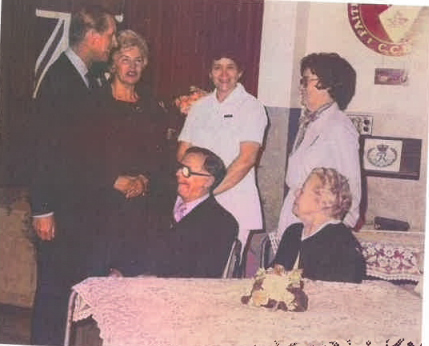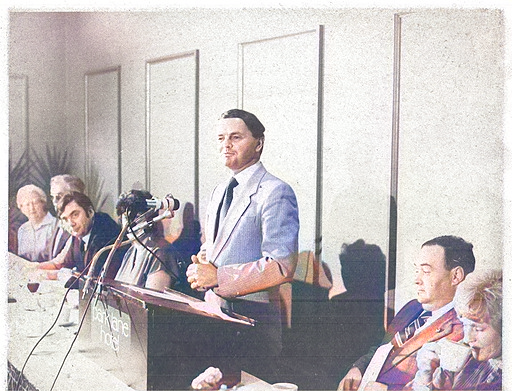
Ten individuals with vision loss in Toronto come together with a singular mission: to illuminate the path toward a brighter future for people who were blind or partially-sighted.
The Inter-Provincial Council of the Blind is eventually formed (originally made up of the Manitoba League of the Blind and the London Association of the Blind of Ontario.

During this year, the Inter-Provincial Council of the Blind officially became the Canadian Council of the Blind (CCB) and started receiving support from the Canadian National Institute for the Blind (CNIB). The CCB is unique as it is governed and operated by individuals who are blind or partially sighted. The support from CNIB funds various CCB activities, and this year also marks the launch of the annual White Cane Week, a public awareness campaign.
This year, the focus of White Cane Week has shifted from raising general awareness about blindness to advocating for better legislation for Canadians living with blindness. Additionally, the debut of The CCB Outlook, the official quarterly magazine of the Canadian Council of the Blind (CCB), marks an important milestone as it serves as the voice of the organization.

CCB’s Recreation Committee is established this year, initially offering concerts and games like cribbage and bingo, but expanding significantly over the years.Today, the offerings include curling, sailing, baseball, dragon boating, downhill and cross-country skiing, dart throwing, archery, running, cycling, and more, catering to varied interests and abilities.

The CCB is officially chartered and incorporated. The CCB secures representation in every Canadian province.

The CCB raises funds to purchase a mobile eye clinic (MEC) to combat blindness in India, extending crucial eye care services to underserved populations. Decades later, CCB would implement MEC in Canada (Ottawa and surrounding areas) to bring registered optometrists into schools, community centers and retirement homes.
The CCB launches its 30th Anniversary Project, financing 1,000 sight-restoring cataract operations in Bangladesh and contributing to the construction of the female wing of an eye hospital in Bangladesh. Throughout the 1970s and 1980s, the CCB continued its overseas efforts, including a partnership with Operation Eyesight Universal to address curable blindness in Kenya. Domestically, the CCB advocated for eye health education, promoted eye examinations, and facilitated access to visual aids, striving to ensure equitable eye care for all.

The CCB’s membership-driven ethos is central to its collaborative approach and organizational identity and the establishment of the Membership Committee during this year highlights this. Committee members attend local and national forums and information sessions both in person and via teleconference to speak on behalf of CCB members and tirelessly advocate for accessibility and independence in all areas of life for people living with vision loss.

The CNIB starts envisioning financial independence for the CCB, gradually withdrawing funding from local CCB divisions. From this year on, CCB shifts its focus from primarily being a community hub to emphasizing advocacy, prompted by societal changes and the growing importance of political discourse. This transition marks a new era for the organization. A new financial agreement between CCB and CNIB is finalized, marking the CCB's financial autonomy.

The Get Together with Technology (GTT) program was founded by Kim Kilpatrick and Ellen Goodman. It aims to empower individuals with vision loss by providing information, resources, and a supportive network for using accessible technologies.
CCB implements the Mobile Eye Clinic (MEC) in Ottawa to deliver eye exams to underserved communities in the area.

The CCB's Experience Expo, part of White Cane Week, is initiated by the Toronto Visionaries Chapter and becomes Canada's sole exposition for people with vision loss, amplifying awareness and understanding of blindness-related issues.
CCB plays a pivotal role in the 2019 passage of the Accessible Canada Act, a landmark legislation aimed at fostering equality and inclusion for Canadians with Disabilities.

CCB collaborated with the federal government of Canada and other stakeholders to support Bill C-284, “An act to establish a national strategy for eye care,” a Private Member’s Bill introduced by the Honourable Judy A. Sgro, MP for Humber River-Black Creek, which aims to establish a national strategy for eye disease prevention, treatment, and vision rehabilitation.
the CCB has actively pursued research endeavors independently and through strategic partnerships, notably with Fighting Blindness Canada, the largest charitable funder of vision research in Canada.
In other recent advocacy efforts, the CCB has been actively working toward reforming Ontario’s Assistive Devices Program (ADP). This program is a vital resource, offering partial funding for essential assistive devices crucial for individuals with long-term physical disabilities, including those with vision loss.
